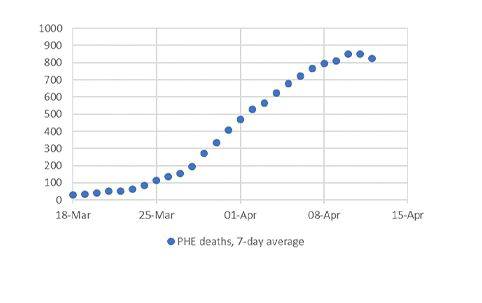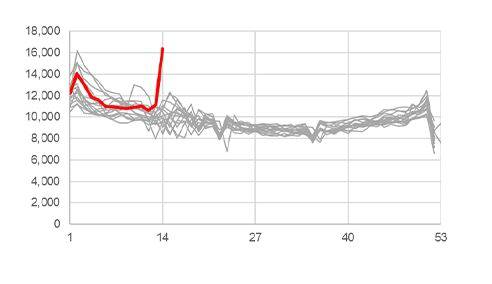Jon Palin is a Partner in Barnett Waddingham’s Longevity Consulting practice.
Our earlier article showed an exponential trend in cumulative deaths up to 1 April 2020, but more recent data shows slower growth since then. Chart 1 compares the actual PHE data to a trend based on data reported up to 1 April 2020. The actual data is well below the previous trend, suggesting that the measures taken to slow the spread of the coronavirus are working.
Chart 1 – Cumulative reported Covid-19 deaths in hospitals, compared to an exponential trend
Another way of analysing the same data is to look at the numbers of daily deaths. The reported figures seem to be affected by weekends, typically being lower on Sunday and Monday, so we use an average to smooth out this effect. Chart 2 shows seven-day averages, plotted against the middle of the seven-day period. It suggests that we may have just passed the peak for reported Covid-19 deaths in hospitals.
Chart 2 – Weekly average of reported Covid-19 deaths in hospitals
Excess deaths from all causes
While the PHE data above gives a useful indication of the current trend, we are most interested in the impact of the pandemic on total mortality. Our earlier blog noted several reasons why “excess” mortality, above what we would have seen in the absence of the pandemic, could differ from deaths attributed to coronavirus.
The latest provisional weekly deaths data published by the Office for National Statistics (ONS) allows analysis of “excess” mortality.
The new data shows the number of deaths registered within week 14 of 2020 (from 28 March to 3 April 2020).
Chart 3 shows weekly registered deaths from 2005 to 2020 by week number, with 2020 highlighted. The latest week has a higher number of deaths than any other week shown, and the more recent PHE data discussed above suggests that deaths in week 15 will be even higher.
Chart 3 – Weekly registered deaths in England & Wales
The Continuous Mortality Investigation (CMI) published analysis of the new ONS data this week. It estimates “expected” deaths, if mortality rates had been the same as in 2019, and calculates “excess” deaths by comparing actual and expected deaths. The CMI analysis shows that the number of excess deaths in week 14 is over 75% higher than the number of deaths for which Covid-19 is mentioned on the death certificate.
Considering the more recent PHE data, and allowing for other differences between the ONS and PHE data, the CMI thinks that there may already have been over 25,000 more deaths in the UK than we would have seen without the coronavirus pandemic.
Impact on longevity assumptions
Our earlier article reported the view of the medical director of NHS England, that restricting the number of deaths due to Covid-19 in the UK to 20,000 would be a “good result”. If we treat all excess mortality as being due to Covid-19 then the CMI’s analysis suggests that we have sadly already passed that number.
If the fall in deaths mirrors the rise shown in Chart 2, then we might see of the order of 50,000 excess deaths from the initial wave.
But there is still considerable uncertainty about this: there is some evidence from other countries that the decline in deaths could be slower than the rise, and it is not clear how and when restrictions on movement will be relaxed, how quickly an effective vaccine can be developed, or whether we will see future waves of Covid-19 deaths.
If there are 50,000 excess deaths, then the analysis in our earlier blog suggests that the direct impact on longevity liabilities, through pension scheme members or annuitants dying, would still be relatively small, and the impact on base mortality would also be small.
However, 50,000 excess deaths in 2020 would lead to a mortality improvement well outside the usual range and could lead to implausible results from some mortality projection models. It looks increasingly likely that such models may need to be revised, taking account of the possible longer-term impact of Covid-19 on longevity.
|





